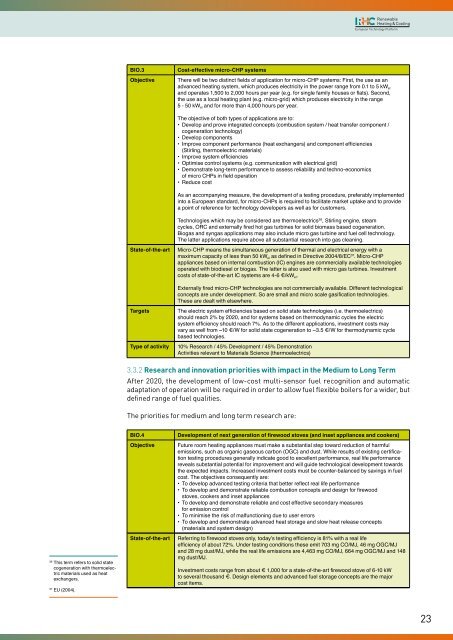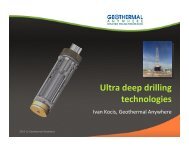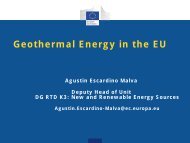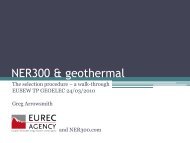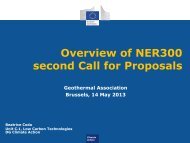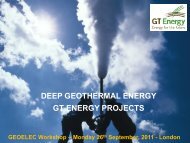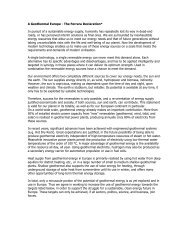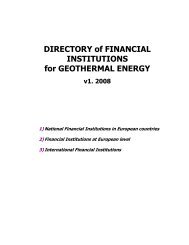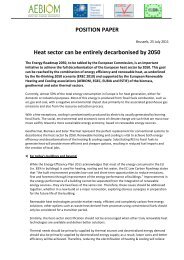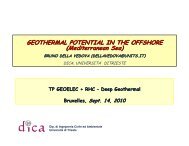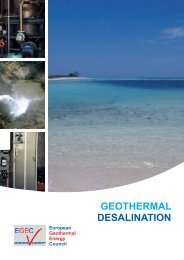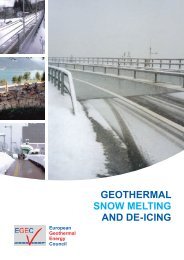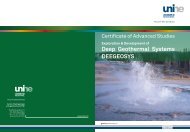3<strong>Strategic</strong> <strong>Research</strong> <strong>and</strong> <strong>Innovation</strong> <strong>Agenda</strong> <strong>for</strong> <strong>Renewable</strong> Heating & CoolingRHC applications <strong>and</strong> priorities <strong>for</strong> residential buildingsThe priorities <strong>for</strong> short term research are:BIO.1ObjectiveImprove system design of residential biomass heating systemsThe objective is to close the gap between steady-state testing <strong>and</strong> real life per<strong>for</strong>mance ofresidential biomass heating systems without additional costs <strong>for</strong> customers. This is to increasesystem efficiency to >85% <strong>and</strong> to reduce real life emissions (CO, OGC <strong>and</strong> dust) by 50%.To do so, advanced cyclic testing procedures are required, guiding component <strong>and</strong> technologydevelopment towards advanced system thinking <strong>and</strong> providing a novel point of reference <strong>for</strong>component <strong>and</strong> technology design.Component <strong>and</strong> technology development focuses on primary <strong>and</strong> secondary measures toreduce emissions, secondary measures <strong>and</strong> new heat storage concepts to increase efficiency.Improved system design <strong>and</strong> intelligent control concepts (e.g. to reduce the number of start <strong>and</strong>stop cycles) are crucial to support both objectives. The development of optimum system designmust consider trade-offs between complexity <strong>and</strong> costs.State-of-the-art biomass heating systems must be available at significantly reduced investmentcost in 2020.State-of-the-art Today, the average efficiency of wood boilers under test conditions is well above 90%,however barely 75% is reached in real life operation (when efficiency is assessed in coldweather as well as milder weather). Emissions of manually stoked boilers are 100 mg CO/MJ,5 mg OGC/MJ <strong>and</strong> 15 mg dust/MJ, <strong>and</strong> emissions <strong>for</strong> automatically stoked boilers are 50 mgCO/MJ, 3 mg OGC/MJ <strong>and</strong> 10 mg dust/MJ. Real life auxiliary electric energy dem<strong>and</strong> is about3% <strong>for</strong> automatic systems.The investment cost of a typical modern pellet-based heating system of 20 kW is about€ 20,000 including all equipment usually installed in the cellar <strong>and</strong> the costs <strong>for</strong> indoor pelletsstorage <strong>and</strong> automatic pellets feeding. Investment costs <strong>for</strong> a wood chip boiler heating systemof the same size are about 20% higher because of higher storage <strong>and</strong> fuel feeding system costs.Investment costs <strong>for</strong> firewood boiler plus heat store will cost about half that of the pellet-basedheating system.Development trends have gone mostly towards high-tech / high price products in recent years.TargetsReal life system efficiency of residential biomass heating systems should reach a systemefficiency of 85% in 2020. Emissions should reach today’s steady-state testing values.Cost-competitive hybrid concepts (biomass / solar, biomass / ventilation) must be demonstrated.Auxiliary electrical energy dem<strong>and</strong> <strong>for</strong> automatic heating systems (not taking into account hybridsolutions) should be reduced by 1/3 <strong>and</strong> system investment costs shall be reduced by 20%(not taking into account hybrid solutions).Investment cost of biomass boilers will be reduced by 1/3 in 2020 compared to today.Type of activity10% <strong>Research</strong> / 30% Development / 60% DemonstrationBIO.2ObjectiveDemonstrate the potential of efficient biomass boilers <strong>and</strong> stoves to improveair quality <strong>and</strong> reduce energy consumptionThe main objective is to demonstrate through technology <strong>and</strong> ambient air quality monitoringthat the substitution <strong>and</strong> retrofitting of the existing stock of small scale biomass combustionappliances <strong>and</strong> residential heating systems can substantially improve quality of ambient air<strong>and</strong> contribute to an increase of energy efficiency.Demonstration areas shall cover rural, small urban, <strong>and</strong> potentially also selected districtsof large urban areas, each of which in different geographic (<strong>and</strong> climatic) regions in Europe,<strong>and</strong> shall take into account the state-of-technology <strong>and</strong> economic boundary conditions ofthe considered geographic regions, i.e. to consider the appropriate technologies <strong>for</strong> eachdemonstration area.Derived data shall serve <strong>for</strong> modelling purposes to support <strong>for</strong>ecasting <strong>and</strong> decision support<strong>for</strong> policy makers. In order to obtain a sufficient exchange or retrofit rate, it will be essentialto involve local authorities, local professionals (chimney sweeps, installers), <strong>and</strong> technologyproviders (chimney manufacturers, stove <strong>and</strong> boiler manufacturers), <strong>and</strong> to develop smartconcepts <strong>for</strong> attracting the individual home owners to join exchange <strong>and</strong> retrofit campaigns.State-of-the-artTargetsType of activitySmall scale biomass combustion systems have reached a high per<strong>for</strong>mance level regardingemission <strong>and</strong> efficiency. Until today, however, this improvement could only be demonstratedunder test-st<strong>and</strong> conditions. Based on the results of several scientific studies investigatingsources of particulate matter emissions, many local <strong>and</strong> national authorities are aiming atmeasures <strong>for</strong> substantial <strong>and</strong> sustainable PM emission reduction. A broad exchange <strong>and</strong>retrofitting of old biomass combustion technology, which has been identified as major primaryemitter of PM in Europe, could lead to the expected results. Due to the high costs related tosuch measures many authorities are dem<strong>and</strong>ing a proof (demonstration) of the effectivenessof such measures.• Over 50% exchange (<strong>and</strong>/or retrofit) rate of small scale biomass combustion appliancesolder than 15 years in chosen demonstration area• Over 50% reduction of PM in ambient air coming from biomass combustion• Over 25% increase in efficiency / reduction in fuel consumption20% <strong>Research</strong> / 10% Development / 70% Demonstration22
<strong>Renewable</strong>Heating & CoolingEuropean Technology Plat<strong>for</strong>mBIO.3ObjectiveCost-effective micro-CHP systemsThere will be two distinct fields of application <strong>for</strong> micro-CHP systems: First, the use as anadvanced heating system, which produces electricity in the power range from 0.1 to 5 kW el<strong>and</strong> operates 1,500 to 2,000 hours per year (e.g. <strong>for</strong> single family houses or flats). Second,the use as a local heating plant (e.g. micro-grid) which produces electricity in the range5 - 50 kW el <strong>and</strong> <strong>for</strong> more than 4,000 hours per year.The objective of both types of applications are to:• Develop <strong>and</strong> prove integrated concepts (combustion system / heat transfer component /cogeneration technology)• Develop components• Improve component per<strong>for</strong>mance (heat exchangers) <strong>and</strong> component efficiencies(Stirling, thermoelectric materials)• Improve system efficiencies• Optimise control systems (e.g. communication with electrical grid)• Demonstrate long-term per<strong>for</strong>mance to assess reliability <strong>and</strong> techno-economicsof micro CHPs in field operation• Reduce costAs an accompanying measure, the development of a testing procedure, preferably implementedinto a European st<strong>and</strong>ard, <strong>for</strong> micro-CHPs is required to facilitate market uptake <strong>and</strong> to providea point of reference <strong>for</strong> technology developers as well as <strong>for</strong> customers.Technologies which may be considered are thermoelectrics 36 , Stirling engine, steamcycles, ORC <strong>and</strong> externally fired hot gas turbines <strong>for</strong> solid biomass based cogeneration.Biogas <strong>and</strong> syngas applications may also include micro gas turbine <strong>and</strong> fuel cell technology.The latter applications require above all substantial research into gas cleaning.State-of-the-artMicro-CHP means the simultaneous generation of thermal <strong>and</strong> electrical energy with amaximum capacity of less than 50 kW el as defined in Directive 2004/8/EC 37 . Micro-CHPappliances based on internal combustion (IC) engines are commercially available technologiesoperated with biodiesel or biogas. The latter is also used with micro gas turbines. Investmentcosts of state-of-the-art IC systems are 4-6 €/kW el .Externally fired micro-CHP technologies are not commercially available. Different technologicalconcepts are under development. So are small <strong>and</strong> micro scale gasification technologies.These are dealt with elsewhere.TargetsType of activityThe electric system efficiencies based on solid state technologies (i.e. thermoelectrics)should reach 2% by 2020, <strong>and</strong> <strong>for</strong> systems based on thermodynamic cycles the electricsystem efficiency should reach 7%. As to the different applications, investment costs mayvary as well from ~10 €/W <strong>for</strong> solid state cogeneration to ~3.5 €/W <strong>for</strong> thermodynamic cyclebased technologies.10% <strong>Research</strong> / 45% Development / 45% DemonstrationActivities relevant to Materials Science (thermoelectrics)3.3.2 <strong>Research</strong> <strong>and</strong> innovation priorities with impact in the Medium to Long TermAfter 2020, the development of low-cost multi-sensor fuel recognition <strong>and</strong> automaticadaptation of operation will be required in order to allow fuel flexible boilers <strong>for</strong> a wider, butdefined range of fuel qualities.The priorities <strong>for</strong> medium <strong>and</strong> long term research are:36This term refers to solid statecogeneration with thermoelectricmaterials used as heatexchangers.37EU (2004).BIO.4ObjectiveState-of-the-artDevelopment of next generation of firewood stoves (<strong>and</strong> inset appliances <strong>and</strong> cookers)Future room heating appliances must make a substantial step toward reduction of harmfulemissions, such as organic gaseous carbon (OGC) <strong>and</strong> dust. While results of existing certificationtesting procedures generally indicate good to excellent per<strong>for</strong>mance, real life per<strong>for</strong>mancereveals substantial potential <strong>for</strong> improvement <strong>and</strong> will guide technological development towardsthe expected impacts. Increased investment costs must be counter-balanced by savings in fuelcost. The objectives consequently are:• To develop advanced testing criteria that better reflect real life per<strong>for</strong>mance• To develop <strong>and</strong> demonstrate reliable combustion concepts <strong>and</strong> design <strong>for</strong> firewoodstoves, cookers <strong>and</strong> inset appliances• To develop <strong>and</strong> demonstrate reliable <strong>and</strong> cost effective secondary measures<strong>for</strong> emission control• To minimise the risk of malfunctioning due to user errors• To develop <strong>and</strong> demonstrate advanced heat storage <strong>and</strong> slow heat release concepts(materials <strong>and</strong> system design)Referring to firewood stoves only, today’s testing efficiency is 81% with a real lifeefficiency of about 72%. Under testing conditions these emit 703 mg CO/MJ, 46 mg OGC/MJ<strong>and</strong> 28 mg dust/MJ, while the real life emissions are 4,463 mg CO/MJ, 664 mg OGC/MJ <strong>and</strong> 148mg dust/MJ.Investment costs range from about € 1,000 <strong>for</strong> a state-of-the-art firewood stove of 6-10 kWto several thous<strong>and</strong> €. Design elements <strong>and</strong> advanced fuel storage concepts are the majorcost items.23


